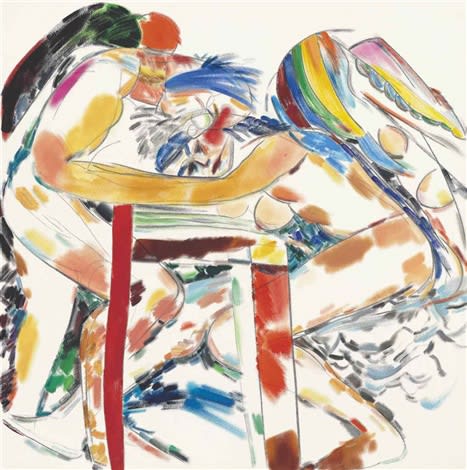R.B. Kitaj 1932-2007
Los Angeles No. 1, 2000
oil on canvas
48 x 48 inches
121.9 x 121.9 cm
121.9 x 121.9 cm
signed, dated and titled on the canvas overlap
This is the first painting in Kitaj’s Los Angeles series – a major body of work which eventually comprised over 20 paintings, the first 8 of which were included in...
This is the first painting in Kitaj’s Los Angeles series – a major body of work which eventually comprised over 20 paintings, the first 8 of which were included in the exhibition Kitaj In the Aura of Cézanne and Other Masters at the National Gallery, London. The subject of these paintings is Kitaj’s wife, the artist Sandra Fisher, who died suddenly of an aneurism in 1994. In the Los Angeles pictures, Kitaj portrays himself meeting Sandra in the after-life, in a series of imagined, and often erotic, scenes. Kitaj had moved to Los Angeles soon after Sandra’s death, so the series’ title refers to his home, but is also a play on the name ‘The City of Angels’. Through these works, the very act of painting became the means for Kitaj to reconnect with his beloved wife, in 2003, Kitaj described how ‘Sandra and I became Lovers again after her death, in my old age, in Los Angeles, The Angels. I could make love to my angel with my paintbrush, fondle her again, caress her contours.’ 1
Here the couple face one another across a table - Kitaj is older now, whilst Sandra is forever young, a vision of vitality and beauty. Their arms appear fused together, Kitaj’s head presses down on Sandra’s, and their knees touch creating a symmetrical composition with an enclosed central space. This image quotes directly from Cézanne’s The Large Bathers, 1900-1905, in which the female bathers’ arms suggest a continuous form, and the trees meet at the top edge of the canvas forming a similarly complete diamond shape. In the catalogue which accompanied Kitaj’s National Gallery exhibition curator Colin Wiggins observes that Kitaj ‘has one black wing, the colour of mourning and one red wing, the colour of blood or sacrifice. He doesn’t want her to go and tries to pin her down on the table’. 2
Here Kitaj takes influence from Cézanne’s watercolour technique, applying thin washes of paint to the canvas, his handling looser and more expressionistic than in previous works. The paintings are characterised by wavering lines and areas of white space, representing Emily Dickinson’s ‘White Exploit’- her term for death. The formal tension structured within the composition, the rainbow of delicate colours and the image of entangled limbs exquisitely describe Kitaj’s inability to let go of his wife. It is a heartbreaking and deeply romantic image which sets the tone for the rest of the series.
1 The artist quoted in ‘Los Angeles’, Los Angeles Pictures, exhibition catalogue, LA Louver, California, 2003, p10
2 Kitaj In the Aura of Cezanne and Other Masters, exhibition catalogue, National Gallery, London, 2002, p15
Here the couple face one another across a table - Kitaj is older now, whilst Sandra is forever young, a vision of vitality and beauty. Their arms appear fused together, Kitaj’s head presses down on Sandra’s, and their knees touch creating a symmetrical composition with an enclosed central space. This image quotes directly from Cézanne’s The Large Bathers, 1900-1905, in which the female bathers’ arms suggest a continuous form, and the trees meet at the top edge of the canvas forming a similarly complete diamond shape. In the catalogue which accompanied Kitaj’s National Gallery exhibition curator Colin Wiggins observes that Kitaj ‘has one black wing, the colour of mourning and one red wing, the colour of blood or sacrifice. He doesn’t want her to go and tries to pin her down on the table’. 2
Here Kitaj takes influence from Cézanne’s watercolour technique, applying thin washes of paint to the canvas, his handling looser and more expressionistic than in previous works. The paintings are characterised by wavering lines and areas of white space, representing Emily Dickinson’s ‘White Exploit’- her term for death. The formal tension structured within the composition, the rainbow of delicate colours and the image of entangled limbs exquisitely describe Kitaj’s inability to let go of his wife. It is a heartbreaking and deeply romantic image which sets the tone for the rest of the series.
1 The artist quoted in ‘Los Angeles’, Los Angeles Pictures, exhibition catalogue, LA Louver, California, 2003, p10
2 Kitaj In the Aura of Cezanne and Other Masters, exhibition catalogue, National Gallery, London, 2002, p15
Provenance
Marlborough Gallery, New YorkPrivate Collection, USA, since 2002
Exhibitions
London, National Gallery, Kitaj: In the Aura of Cézanne and Other Masters, 7 November 2001 – 10 February 2002, cat no.2, pp15-18, illus colour fig.14New York, Marlborough Contemporary, R.B. Kitaj: The Exile at Home, 4 March – 8 April 2017, cat no.41, illus colour p41
Literature
Marco Livingstone, Kitaj, Phaidon, London, 2010, cat no.788, illus colour pl.233Join our mailing list
* denotes required fields
We will process the personal data you have supplied to communicate with you in accordance with our Privacy Policy. You can unsubscribe or change your preferences at any time by clicking the link in our emails.
